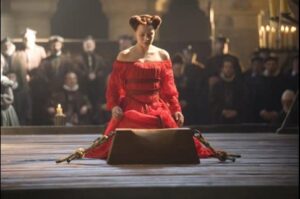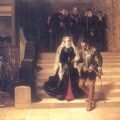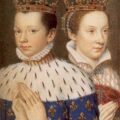
In my previous article on Mary Queen of Scots, “The Trial of Mary Queen of Scots”, I told of how Elizabeth did not sign Mary’s death warrant until the 1st February 1587 and we know that she gave orders for it not to be sent to Fotheringhay until she said so. It is clear that Elizabeth was struggling with taking such action against a fellow queen, an anointed sovereign, and a woman with Tudor blood. The idea of regicide horrified her but her Parliament were calling for action and a strong monarch always acts against those who conspire to dethrone and assassinate them. It surely would have been a sign of weakness if Elizabeth had let Mary go on plotting against her.
It seems from Elizabeth’s actions – signing the death warrant but not sending it, asking Paulet to kill Mary under the Bond of association – that she was trying to deal with Mary without taking any responsibility for what happened. As John Guy says, “She had carefully contrived things so that she would win whatever happened. If Mary was killed under the Bond of Association, Elizabeth could disclaim responsibility. If Cecil covertly sealed the warrant and sent it to Fotheringhay behind her back, she could claim she had been the victim of a court conspiracy.” But we cannot know for sure what was going through Elizabeth’s mind at that time. Elizabeth was caught between a rock and a hard place, as Alison Weir describes:-
“If she signed the warrant she would be setting a precedent for condemning an anointed queen to death, and would also be spilling the blood of her kinswoman. To do this would court the opprobroum of the whole world, and might provoke the Catholic powers to vengeful retribution. Yet, if she showed mercy, Mary would remain the focus of Catholic plotting for the rest of her life, to the great peril of Elizabeth and her kingdom. Elizabeth knew where her duty lay, but she did no want to be responsible for Mary’s death.”1
No wonder she procrastinated! What a decision to have to make and I don’t think anyone can blame her for taking her time, for refusing to bow to Parliamentary pressure and for taking steps to distance herself from what happened in the end. What else could she do?
Mary – Tragic Heroine and Martyr?
Recently, this site has been bombarded with comments (see comments on Free Report page and my article on Mary’s trial) proclaiming Mary Queen of Scots’ innocence, protesting that she was the rightful queen of England, Scotland and France, calling Elizabeth a “Killer queen”, accusing Elizabeth of framing Mary and accusing me of romanticising Elizabeth. They were hard to take seriously when that person also thought that Mary Queen of Scots was the daughter of Mary I (!), but they did make me think about how Mary has been romanticised in the past and seen as a tragic heroine and even a Catholic martyr. Even today, she is proclaimed a martyr, not just by the commenter on this site but also the the New Advent Catholic Encylopedia who say:-
“There can be no question that she died with the charity and magnanimity of a martyr; as also that her execution was due, on the part of her enemies, to hatred of the Faith.”2
and then write of how Pope Benedict XIV would have formally declared her a martyr “if only the charges connected with the names of Darnley and Bothwell could be entirely eliminated”3.
Mary saw herself as a martyr. At her execution, on the 8th February 1587, she wore a crucifix and a black gown and as she prepared herself for her beheading she took off her gown to reveal a bodice and petticoat of scarlet, the colour of martyrdom. In her final moments she was proclaiming that she was a martyr to her faith.
However, whatever Mary thought and whatever message she was sending by her garb, I don’t believe that she was a martyr, well, not in the sense that she meant.
martyr – noun (mär-tər)
- a person who voluntarily suffers death as the penalty of witnessing to and refusing to renounce a religion
- a person who sacrifices something of great value and especially life itself for the sake of principle
- victim; especially : a great or constant sufferer4
Perhaps she could be seen as a martyr according to definitions 2) and 3), but she did not died for her Catholic faith, she was executed because she plotted to kill the Queen of England. Uh oh, now I’m treading on dangerous ground with those who believe she was framed. Well, I do believe that William Cecil and Sir Francis Walsingham did all they could to bring down Mary Queen of Scots, but I don’t believe that they framed her. They set a trap and she fell into it. She gave them the evidence that they were looking for and that they needed to convince Elizabeth to get rid of her once and for all.
John Guy, in his book “Mary Queen of Scots: My Heart is My Own” explains Walsingham and Cecil’s roles in the downfall of Mary Queen of Scots brilliantly:-
“the plot [Babington plot] was not in itself a ‘projection’ [using agent provocateurs to foment conspiracies that were then conveniently ‘detected’] to frame her – it really existed; but rather than nipping it in the bud, Cecil’s spymaster allowed it to develop so that he could obtain the written evidence to put her on trial for her life”. Walsingham and Cecil let the plot continue so that Mary would ‘hang herself’ by getting involved and she did by replying to Babington who was conspiring to get Elizabeth assassinated by a group of ’six gentlemen’:-
‘The affairs being thus prepared and forces in readiness both without and within the realm, then shall it be time to set the six gentlemen to work taking order, upon the accomplishing of their design, I may be suddenly transported out of this place, and that all your forces in the same time be on the field to meet me in tarrying for the arrival of the foreign aid, which then must be hastened with all diligence.’ “5
John Guy comments that “Mary’s meaning is clear. She had consented to Elizabeth’s assassination and a foreign invasion. Strictly, she had not specified what the ‘work’ of the six gentlemen was to be, but the letter from Babbington to which she was replying included the graphic passage, ‘For the dispatch of the usurper, from the obedience of whom we are by the excommunication of her made free, there are six noble gentlemen, all my private friends, who for the zeal they bear to the Catholic cause and your Majesty’s service will undertake that tragical execution.’ When the two letters are read together, Mary’s complicity in the plot was undeniable.”6
Cecil and Walsingham did not frame Mary, they laid a trap and she condemned herself with her own words and actions. She was clearly giving her blessing and her support to Babington’s plot to assassinate Elizabeth. What’s more, Babington confessed and so did Mary’s secretaries.
The Babington Plot was not a one-off, it was not the only time that Mary had conspired against Elizabeth, and as early as 1568 she had approached Philip II to help her with her cause. She also never gave up on her claim to the English throne. Elizabeth spent two decades giving Mary the benefit of the doubt and sympathising with her, yet Mary carried on plotting. I just can’t see Mary as a tragic heroine or martyr and Elizabeth as a cold-blooded killer, however I look at the situation.
What do you think?
Please share your thoughts in comments below – thank you!
Notes and Sources
- “Elizabeth, the Queen”, Alison Weir, p375
- Mary Queen of Scots, New Advent Catholic Encyclopedia
- Ibid.
- Merriam-Webster
- My Heart is My Own: The Life of Mary Queen of Scots, John Guy, p483.
- Ibid.






